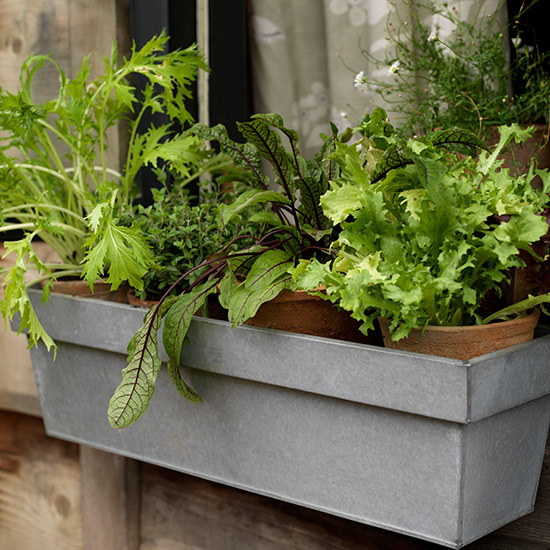Eight tips for window box planting
A well cared for window box can provide an impressive yield of salad leaves, herbs and even vegetables
If you don't have much outdoor space but are feeling the urge to get greenfingered, a window box is sure to provide some gardening satisfaction. We asked Mike Kitchen, the founder of Rocket Gardens to for some advice on how to get started.

1. Choose a warm sunny window sill - ideally one that receives morning sun - and make sure your window box is secured well. A wide sill that catches the rain would be ideal.
2. Grow edible plants - try dwarf french beans, mixed lettuces, spring onions, beetroot, basil, salad leaves, parsley and chives. If you are short on outside space then grow plants like basil and tomatoes indoors on a sunny sill. These type of plants will appreciate the warmth that is afforded from being inside.
3. Make sure your window boxes have some good drainage holes and also fill the bottom of the box with broken pieces of old teracortta pots to improve soil drainage.
4. Fill your window boxes with a good quality organic compost such as Moorland Gold Potting &
Container Compost. Make sure that your window boxes are deep enough for the plants that you intend to grow. A small, shallow window box (10-20 cm) is fine for salad leaves and lettuce. Plants such as carrots will require more depth, ideally around 30 cm.
5. Watering can be a big problem on windowsills - containers dry out very quickly when it's hot and sunny, and often rain can't reach them because of roof overhangs. Water your plants regularly but don't overwater as that can drown them. Test if you've got it right by poking a finger into the compost.
If it's slightly moist just below the surface, that's perfect.
6. When growing fresh leaves such as rocket, mizuna or rainbow chard make sure you harvest the leaves carefully with scissors a little and often to allow for a longer cropping period.
Get the Ideal Home Newsletter
Sign up to our newsletter for style and decor inspiration, house makeovers, project advice and more.
7. Don't forget to feed your plants once they are established. Living in pots and boxes, they'll soon use up all the nutrients in their compost. It is well worth popping a scoop of natural wormcast fertiliser in with each plant as you pop them into your window box. This is a good long term feed which will keep your plants happy and healthy throughout the growing season. You can also use a liquid feed every couple of weeks for greedy plants such as tomatoes and peppers which will produce heavier crops when well fed.
8. If you have the room it's also a really good idea to pop in some companion plants such as French marigolds and nasturtiums which not only look lovely will also help protect your plants from pests.
Tamara was Ideal Home's Digital Editor before joining the Woman & Home team in 2022. She has spent the last 15 years working with the style teams at Country Homes & Interiors and Ideal Home, both now at Future PLC. It’s with these award wining interiors teams that she's honed her skills and passion for shopping, styling and writing. Tamara is always ahead of the curve when it comes to interiors trends – and is great at seeking out designer dupes on the high street.
-
 Martin and Shirlie Kemp’s pastel flower beds has given their Victorian renovation a romantic look - how you can get the look
Martin and Shirlie Kemp’s pastel flower beds has given their Victorian renovation a romantic look - how you can get the lookTheir pastel garden is the cottage garden inspo you've been looking for
By Kezia Reynolds
-
 7 outdated rules to ignore when designing a small patio – experts say ditching them will transform your space
7 outdated rules to ignore when designing a small patio – experts say ditching them will transform your spaceThese are the traditional patio design rules you don’t always need to follow
By Rebecca Lawton
-
 Who is responsible for repairing a party wall?
Who is responsible for repairing a party wall?How to find out who should be organising and paying for the work
By Natasha Brinsmead